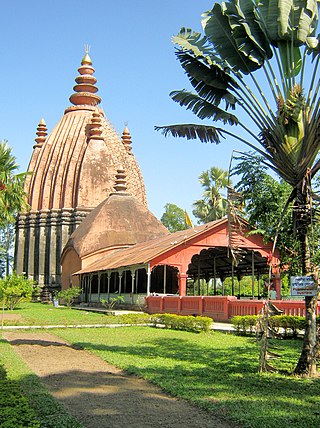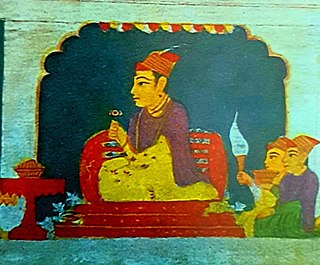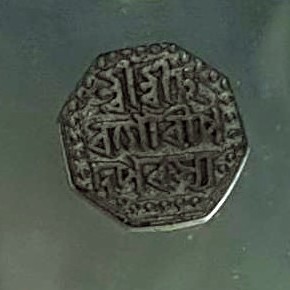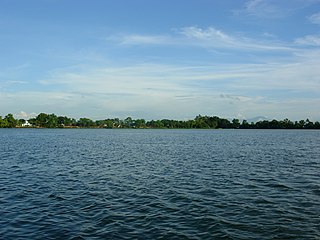
The Ahom dynasty (1228–1826) ruled the Ahom Kingdom in present-day Assam, India for nearly 598 years. The dynasty was established by Sukaphaa, a Shan prince of Mong Mao who came to Assam after crossing the Patkai mountains. The rule of this dynasty ended with the Burmese invasion of Assam and the subsequent annexation by the British East India Company following the Treaty of Yandabo in 1826.

The Kamakhya Temple at Nilachal hills in Guwahati, Assam is one of the oldest and most revered centres of Tantric practices, dedicated to the goddess Kamakhya. The temple is the center of the Kulachara Tantra Marga and the site of the Ambubachi Mela, an annual festival that celebrates the menstruation of the goddess. Structurally, the temple is dated to the 8th-9th century with many subsequent rebuildings—and the final hybrid architecture defines a local style called Nilachal. It is also one of the oldest of the 51 pithas in the Shakta tradition. An obscure place of worship for much of history it became an important pilgrimage destination, especially for those from Bengal, in the 19th century during colonial rule.

Sivasagar, is a city in and headquarters of the Sivasagar district, Assam. Sivasagar is situated about 360 kilometers (224 mi) northeast of Guwahati. It is well known for its Ahom palaces and monuments. Sivasagar is an important centre for tea and oil industries today. Sivasagar is a part of Jorhat. Akhil Gogoi is the current MLA of Sibsagar.

Sivasagar district, formerly known as Sibsagar, is one of the 34 districts of Assam state in Northeast India. Sivasagar city is the administrative headquarters of this district. This historic place is also known for its rich biodiversity. The districts covers an area of 2668 square kilometers. The district comprises two sub-divisions – Sivasagar and Nazira. The district of Sivasagar lies between 26.45°N and 27.15°N latitudes and 94.25°E and 95.25°E longitudes. The district is bounded by the Brahmaputra River to the north, Nagaland to the south, the Charaideo district to the east and the Jhanji River to the west. The Sivasagar district has acquired its distinct identity due to the co-existence of different races, tribes, languages and cultures.

The Ahom kingdom was a late medieval kingdom in the Brahmaputra Valley in Assam. It maintained its sovereignty for nearly 600 years having successfully resisted Mughal expansion in Northeast India. Established by Sukaphaa, a Tai prince from Mong Mao, it began as a mong in the upper reaches of the Brahmaputra based on wet rice agriculture. It expanded suddenly under Suhungmung in the 16th century and became multi-ethnic in character, casting a profound effect on the political and social life of the entire Brahmaputra valley. The kingdom became weaker with the rise of the Moamoria rebellion, and subsequently fell to repeated Burmese invasions of Assam. With the defeat of the Burmese after the First Anglo-Burmese War and the Treaty of Yandabo in 1826, control of the kingdom passed into East India Company hands.
Supaatpha also, Gadadhar Singha established the rule of the Tungkhungia clan of the Ahom kings that ruled the Ahom kingdom till its climactic end. He was the son of Gobar Roja, a descendant of Suhungmung, and who had become the king for a mere 20 days. Previously known as Godapani, Supatphaa was able to stabilize the kingdom after the decade-long turmoil following the Ahom victory in the Battle of Saraighat. This period saw the ruthless power grab of Debera Borbarua and Laluksola Borphukan's abandonment of Guwahati and oppression via Sulikphaa Lora Roja. Supatphaa retook Guwahati from the Mughals for good, and established a strong rule of 'blood and iron'. He came into conflict with the Mayamara Vaishnava sattra which belonged to the folds of Kal "songhoti"and made way for Rudra Singha, his son and succeeding king, to take the kingdom to its zenith.
Joymoti Konwari, was the wife of Tai-Ahom Prince Gadapani. She was accorded the honorific Mohiyokhi on account of her heroic endurance of torture until the end, dying at the hands of royalists under Sulikphaa Loraa Roja without disclosing her exiled husband Prince Gadapani's whereabouts, thereby enabling her husband to rise in revolt and assume kingship. Gadapani and Joymoti's son Rudra Singha had the Joysagar Tank dug at the spot where she was tortured. The first Assamese film Joymoti, directed in 1935 by Jyoti Prasad Agarwala, was based on her life.

Sukhrungphaa also Swargadeo Rudra Singha, was a Tungkhungia ahom king and 30th king of the Ahom kingdom who reigned from 1696 to 1714. Under whom the kingdom reached its zenith of power and glory, he is considered as the most illustrious of the Ahom kings. At Gadadhar Singha's death, his elder son Lai ascended the throne with the Ahom name of Sukharngpha and the Hindu name of Rudra Singha. He is best known for building a coalition of rulers in the region and raising a vast composite army against the Mughal Empire. He died on the eve of his march west from Guwahati. He had subjugated the Jayantias and the Kachari kingdoms in (1707). He built a new capital at Meteka and named it as Rangpur. Rudra Singha, following the words of his father, decided to reinstate the Vaishnava Gosain and Mahantas, he had settled the Satras in Majuli being nearer to the Ahom metropolis. He had received the initiation of Auniati Gosain, Haridev.

Rangpur is the 4th capital of the Ahom kingdom, was established by Swargadeo Rudra Singha in "Meteka" in 1707 after shifting the capital from Garhgaon. It is currently a part of Sibsagar town. The place holds many monuments build by the Ahom dynasty, the most notable of which are the Talatal Ghar and the Rang Ghar.

Suremphaa, or Rajeswar Singha, the fourth son of Rudra Singha, became the king of the Ahom kingdom after the death of his brother King Pramatta Singha. Rudra Singha's third son, Mohanmala Maladev Gohain, was considered ineligible for kingship as his face was pitted with smallpox marks. According to the norm established after Sulikphaa Lora Roja, an Ahom prince had to be free from any physical disability, defects or deformities to become a king.

Shiva dol is a group of structures comprising three Hindu temples of Sivadol, Vishnudol and Devidol shrines, and a museum. These are located on the banks of the Sivasagar tank, also known as the Borpukhuri tank, in the heart of Sivasagar, in the Indian state of Assam. The tank was constructed between 1731 and 1738 and the temples were built in 1734 by Bar Raja Ambika, queen of Ahom king Swargadeo Siva Singha (1714–1744). The height of the Sivadol is 104 feet (32 m) and the perimeter is 195 feet (59 m) at the base. It is crowned with an 8-foot (2.4 m) high golden-dome.

The Rudreswar Temple or Devaloya is a temple dedicated to Lord Shiva in the village of Rudreswar, under Sila Sindhurighopa Mouza, on northern bank of the river Brahmaputra, in Guwahati. Built in 1749 CE by Ahom king Pramatta Singha, in memory of his father Swargadeo Rudra Singha, the temple is a fine example of a mixed style of Ahom-Mughal architecture.

Sutanphaa also Siva Singha was the 31st king of Assam who reigned from He was the eldest son of Rudra Singha. Siva Singha was with his dying father at Guwahati, who then proceeded to the capital Rangpur where he ascended to the throne. He is noted for his elaborate system of espionage. He had numerous temples erected and made large gifts of land to them. With his support Hinduism became the pre-dominant religion of the Ahoms". The king was also a patron of music and literature and music and himself composed Sanskrit songs and learnt songs. During his reign also came the first Europeans to trade with Assam.

The Rang Ghar, is a two-storeyed building which once served as the royal sports-pavilion where Ahom kings and nobles were spectators at games like buffalo fights and other sports at Rupahi Pathar - particularly during the Rongali Bihu festival in the Ahom capital of Rangpur.

Sunyeophaa also Lakshmi Singha, was the 34th Ahom king. After Rajeswar Singha's death, he married Queen Kuranganayani and became the king of the Ahom kingdom. Shortly after he was installed he became a captive of the rebels of the Moamoria rebellion for a few months but soon regained his kingdom. With the help of Kuranganayani, after destroying all the Moamoria rebels including Borbaruah Ragho, Lakhmi Singha was once again crowned as king of Ahom kingdom.

The Talatal Ghar[tɔlatɔl ɡʱɔɹ]) is an 18th century palace and military base located in Rangpur, 4 kilometres (2.5 mi) from present-day Sivasagar, Assam, India. It is the largest of the monument built during the Ahom era. King Rudra Singha was responsible for the construction of Kareng Ghar, but the present structure was built by king Rajeswar Singha (Surempha). It was initially built as an army base. It had 2 tunnels and 3 underground floors. Currently this structure is in dilapidated condition, the present ruins betray the grandeur that the palace was once endowed with.
Mahendra Manikya was the Maharaja of Tripura from 1712 to 1714.

Joysagar Tank, also known as Joysagar Borpukhuri is a large tank located at Sivasagar district, Assam, India. The lake is 5 km from the center of the Sivasagar town. The lake has historical significance.

The Keshavnarayan Vishnu dol, popularly known as Joy dol, was constructed in 1698 by Ahom king Swargadeo Rudra Singha (1696–1714) in honour and memory of his mother Joymoti. Particularly this temple is dedicated to Hindu god Lord Vishnu. The presiding deity of the temple was before known as Kesavaraya Visnu This temple is constructed of brick and stone. The walls are decorated with images of celestial beings and sculptures representing the social life of the day such as the sports and favourite pastimes of the erstwhile Ahom kings. The Joysagar Group of temples standing on the banks of the tank of the same name includes the Joydol, the Sivadol, the Devi Ghar, and the Ghanashyam House.

Na-Pukhuri Shiva Dol or Rudrasagar Shiva Dol in an 18th-century Hindu temple constructed during the reign of king Lakshmi Singha (1769-1780). This temple is 8 km away from Sivasagar town. This is the last temple built during the Ahom era which represents grandeur before its overall decline in temple building and architectural building. This temple is located on the south bank of Rudrasagar Pukhuri which was excavated in honor of Rudra Singha, as this pond was dug on the opposite of Athaiphukhuri, which was dug during the reign of Jayadhwaj Singha this is also called Na-Pukhuri (New-pond) and the former is called Purani Pukhuri (Old-pond).


















